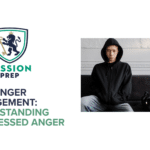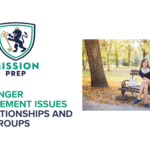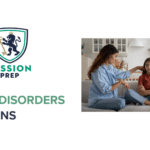What Causes Insecure Attachment? Anger Issues, Causes, Signs, & How Teens Can Recover

Could your teen’s anger be more than just “teenage moodiness”? Perhaps they have outbursts of rage or completely shut down when things don’t go their way. Reactions such as these may be a sign of something deeper, such as emotional wounds or attachment trauma.
Insecure attachment and anger issues in teens can sometimes look like explosive tempers or defiance. Yet understanding where this anger comes from can help your teen feel more secure, calm, and connected with themselves and others.
If you’re concerned about your teen’s anger, professional support is recommended, as it can get to the root causes of emotional dysregulation. This page can also help, as it guides you through what could lie beneath anger and how to find support by covering:
- The connection between anger and insecure attachment
- Signs of insecure attachment in teen aggression
- Long-term effects of untreated anger and attachment
- Therapeutic options for teen anger and insecure attachment
- Where to find professional support

Understanding the Connection Between Insecure Attachment and Anger
As a parent, it’s natural to worry about your teen, especially if they seem to be constantly angry or emotionally unpredictable. However, what many parents don’t realize is that anger often has roots in insecure attachment.
But what is insecure attachment? What causes it? And how is it linked to anger? We’ll answer each of these questions in the following sections.
What Is Insecure Attachment?
Insecure attachment is a pattern of emotional connection that can affect how people manage their emotions and relate to others. Attachment forms during early childhood through the relationship between an infant and their primary caregivers. Consistent patterns of interactions can form a template for how a child relates to themselves and others.
For example, according to attachment theory, when a child receives consistent love, attention, and emotional support, they usually develop a secure attachment. This means they are more likely to trust others appropriately, regulate their own emotions, and form healthy relationships.
However, when a child’s emotional needs are not consistently met, they may develop an insecure attachment. This can result in trust issues, emotional dysregulation, and difficulties creating healthy relationships with others.1 Additionally, if a child doesn’t encounter healing experiences, these challenges can persist into adolescence and adulthood.
There are three main styles of insecure attachment:2
What Causes Insecure Attachment?
When a child develops an insecure attachment, it doesn’t necessarily mean that a parent has done something “wrong.” Instead, it’s the child’s perception of how well their needs are met that can make a difference. Plus, insecure attachment can be caused by circumstances outside of anyone’s control, for example:1,3
- Chronic stress
- Premature birth
- Traumatic experiences
- Genetic factors
- Parental mental health issues
- Caregiving without the necessary parenting skills
- Separation, such as due to adoption or foster care
- Inconsistency in caregiving
- Previous experiences of neglect or abuse
Parenting doesn’t have to be “perfect” for a secure attachment to form. What matters is emotional consistency and availability. If a child reaches out for help and gets unpredictable responses – sometimes comforted, punished, or ignored – they may not trust caregivers to fulfil their needs. This can lead to insecure attachments.
How Is Attachment Linked to Anger?
Attachment typically shapes people’s “blueprints” for handling emotions, otherwise known as “emotional regulation.” For instance, a child with a secure attachment typically learns that it’s OK to be upset: they can manage their feelings and can rely on the support of others.
Alternatively, an insecurely attached child may have learned that emotional expression would be punished or ignored. Therefore, they might feel like they have to either act out further for attention or bottle up their feelings and cope with them alone. Either way, they usually struggle to self-soothe or understand their feelings.
Adolescence is a time of huge change – physically, emotionally, and mentally. If constructive experiences haven’t been implemented, patterns of emotional dysregulation learned in early childhood can continue to impact a teen’s life. As a result, frustration and anger can build up from being unable to identify, express, and manage intense emotions. This can help shed some light on insecure attachment linked to rage episodes and emotional outbursts.
Although attachments are formed in childhood and tend to be stable traits, they aren’t etched in stone: they can be changed. With the right support and understanding, teenagers can discover healthier ways to connect with their emotions, themselves, and others.
How Insecure Attachment Fuels Anger and Emotional Dysregulation
Emotional Dysregulation in Adolescent Attachment Disorder
Teens with an insecure attachment often struggle with emotional regulation. As infants, they may have lacked the consistent emotional support needed to recognize their emotions, learn how to self-soothe, or express themselves. Some may have been punished for crying or being emotional, teaching them that certain feelings aren’t acceptable. Therefore, they may bottle up or stamp down emotions, believing they should handle them independently. In adolescents, this can lead to issues around identifying and communicating how they feel, as well as how to manage intense emotions.4Anger in Teens
Emotionally dysregulated teens can become frustrated from being unable to express themselves clearly enough to get their needs met. They may feel isolated. When they feel like they can’t ask for help and support, frustration can develop and quickly escalate into anger. Additionally, anger may be a response to a perceived threat, such as rejection, or could be used to mask other feelings, such as sadness or shame. This anger may be expressed either outwardly or inwardly. Outward expressions of anger can range from passive-aggressive comments said under one’s breath through to slamming doors, destroying objects, and physical violence. Internalized anger is when someone takes their anger out on themselves, for example, teens withdrawing, self-sabotaging, or even self-harming.Negative Expectations of Relationships
Interpersonal interactions can be challenging for insecurely attached teenagers. For instance, they might have built unhealthy, subconscious coping mechanisms to protect themselves from further harm. They also may not trust others, assuming that they will get hurt. Or, teens may believe that when they are vulnerable, people will reject them. These issues can seriously impact a relationship, whether it’s with family, friends, or a romantic partners. Further, triggering thoughts can cause intense emotional reactions, with teens expressing their pain through anger because they do not know how else to process it.Understanding the link between insecure attachment and anger in teenagers is vital for early intervention. Supportive relationships with others, such as through secure parenting or therapy, can help teens build healthier emotional management.
Long-Term Effects of Untreated Anger and Insecure Attachment
Impact of Untreated Anger
Untreated anger can have far-reaching effects. Those with anger management issues have a higher risk of developing depression, anxiety, or self-harming than those who can manage their anger.5-7 Plus, relationships can be more challenging, as anger can lead to constant conflicts. Without learning how to better manage their emotions, people can fall into their usual response of aggression and unhealthy coping mechanisms. Untreated anger can also have physical consequences, for example:5-7- Pains
- Insomnia
- Hypertension
- Coronary disease
- Weakened immune system
- Stroke
- Cancer
- Gastrointestinal problems
Effects of Untreated Insecure Attachment
Insecure attachment can continue to affect a teen’s life in several ways, and the effects can carry into adulthood. For instance, they may struggle to build healthy relationships and find conflict resolution difficult. Plus, if they are overly self-reliant, they may find themselves feeling lonely, isolated, and unable to reach out for help when they do need it.
Insecure attachment in adolescence also leads to struggles with diminished self-worth, anxiety, and difficulty managing emotions. Bottling up or suppressing feelings can disrupt healthy emotional regulation, leading to stress, anxiety, or depression.
Insecure attachment can also lead to a rare but serious condition called reactive attachment disorder (RAD). If this isn’t treated, it can affect relationships with others, education, work, and mental health throughout their life. Teens with RAD may seem either withdrawn or distant, or can become aggressive and argumentative. This shows a clear link between attachment trauma and behavioral problems.8,9
Signs of Insecure Attachment in Teen Aggression
The exact signs of insecure attachment will depend on the type of attachment, as each has their own set of potential triggers and reactions. For instance, someone with anxious attachment could become triggered by a potential threat to their relationship. In contrast, someone with avoidant attachment may be more triggered by criticism of their performance.
However, there are some general red flags you can watch for. Some of the common signs of insecure attachment in teens with aggression include:10,11
- Difficulty in emotionally connecting with others
- Problems understanding and keeping boundaries
- Fearing vulnerability
- Finding trusting people to be challenging
- Acting aggressively toward their parent or caregiver
- Avoiding physical affection
- “Clingy” behaviors in relationships
- Angry emotional outbursts from emotional dysregulation
- Withdrawing from others
- Difficulty identifying and managing emotions
- Anxiety
- Fearing abandonment or rejection
- Low self-worth
- Impulsive, risky behaviors
If some of these symptoms seem familiar, your teen may have an insecure attachment or an attachment disorder, such as RAD. Remember that support is available and can help teens work toward better emotional regulation and healthier relationships. We shall look at some of the treatment options available to teens with attachment issues and anger problems in the next section.
Mental Health Treatment for Angry Adolescents With Insecure Attachment
Therapy for anger management in insecure teens requires a multi-faceted approach to repair emotional scars associated with insecure attachment and to learn how to manage anger and intense emotions.
You can find out more about options for teen anger treatment here. However, if anger stems from insecure attachment, therapeutic options for healing insecure attachment in teens may be more appropriate. We discuss some of these options below.
Individual Therapy
Therapy on a one-to-one basis can be effective at treating insecure attachments in teenagers. Some of the evidence-based approaches that can be used include DBT for emotion regulation in teens (dialectical behavior therapy), CBT for adolescent anger control (cognitive behavioral therapy), and attachment-based anger therapy (ABT).
DBT teaches teens the skills they need to manage their emotions, such as helping them cope better with distress and communicate more clearly with others. These have a positive effect on emotional regulation, which in turn helps anger management.12
CBT is a structured therapy that helps teens to recognize and change their unhelpful thoughts, beliefs, and behaviors. It involves examining their beliefs about themselves and the world, such as who they can trust or their own self-worth. They can then move forward with more helpful thoughts and behaviors, develop healthier coping mechanisms, and understand what to do when they feel rage building.
ABT can help adolescents work toward a more secure attachment style, called “earned” secure attachment. It uses attachment theory to guide therapy sessions so that patients can understand how their attachment issues developed. By helping teens regulate emotions after trauma, they can then work on exploring issues, building trust, managing anxiety, and anger around relationships.13
Family Therapy
Family counseling for dysregulated teens with insecure attachment styles can provide a valuable opportunity to mend bonds that may have been damaged during early childhood. Attachment-based family therapy, in particular, is an evidence-based approach grounded in attachment theory, which focuses on rebuilding secure emotional bonds. Sessions include interventions to enable teens and their families to heal attachment wounds, develop trust, improve communication, and foster a sense of safety in connections.
Trauma Recovery Programs for Attachment Anger Issues
Treatment programs for aggressive teens can provide a more trauma-focused approach for healing those struggling with complex trauma or risk-taking behaviors. This may be especially helpful when regular outpatient care isn’t giving the hoped-for results.
Trauma recovery programs facilitate a safe and supportive environment for teens to heal while receiving the care they need. They can access therapy, learn coping strategies for anger from attachment trauma, understand their emotions better, and receive guidance from mental health experts.

Finding Compassionate Support With Mission Prep
Healing attachment trauma and aggression in teens doesn’t happen overnight: it’s a process that requires compassion and, often, professional support. If your teen is struggling with anger and attachment issues, know that help is available.
At Mission Prep, we offer teen mental health support through our team of experts. We understand that no two people are the same, which is why we tailor treatment plans to your teen’s needs. Whether you are seeking virtual therapy, face-to-face treatment, medication management, or residential treatment, we have options to suit anyone who needs support.
Reach out to us today to talk through your child’s needs and discover how we can help your family move toward a calmer future.
References
- McGarvie, S., PhD. (2025, March 27). Attachment Theory, Bowlby’s Stages & Attachment Styles. PositivePsychology.com. https://positivepsychology.com/attachment-theory/
- Ainsworth, M. D. S., & Bell, S. M. (1970). Attachment, exploration, and separation: Illustrated by the behavior of one-year-olds in a strange situation. Child Development, 41(1), 49–67. https://doi.org/10.2307/1127388
- Robinson, L., Segal, J., & Jaffe, J. (2025, March 13). Attachment styles and how they affect adult relationships. HelpGuide.org. https://www.helpguide.org/relationships/social-connection/attachment-and-adult-relationships
- Waters, S. F., Virmani, E. A., Thompson, R. A., Meyer, S., Raikes, H. A., & Jochem, R. (2009). Emotion regulation and attachment: Unpacking two constructs and their association. Journal of Psychopathology and Behavioral Assessment, 32(1), 37–47. https://doi.org/10.1007/s10862-009-9163-z
- Mental Health Foundation. (n.d.). Cool Down: Anger and how to deal with it. Retrieved August 20, 2025, from https://www.mentalhealth.org.uk/explore-mental-health/publications/cool-down
- Anxious Minds. (2025, March 27). Understanding anger: Signs, causes and management. https://www.anxiousminds.co.uk/understanding-anger-signs-and-management/
- Department of Health & Human Services. (n.d.). Anger – how it affects people. Better Health Channel. Retrieved August 20, 2025, from https://www.betterhealth.vic.gov.au/health/healthyliving/anger-how-it-affects-people
- Ellis, E. E., Yilanli, M., & Saadabadi, A. (2023, May 1). Reactive attachment disorder. StatPearls – NCBI Bookshelf. https://www.ncbi.nlm.nih.gov/books/NBK537155/
- Kandola, A. (2020, November 2). What is reactive attachment disorder? Medical News Today. https://www.medicalnewstoday.com/articles/reactive-attachment-disorder
- Morin, A. (2023, May 3). Signs and causes of attachment issues. Verywell Mind. https://www.verywellmind.com/what-is-an-attachment-disorder-4580038
- Guyon-Harris, K. L., Humphreys, K. L., Fox, N. A., Nelson, C. A., & Zeanah, C. H. (2018). Signs of attachment disorders and social functioning among early adolescents with a history of institutional care. Child Abuse & Neglect, 88, 96–106. https://doi.org/10.1016/j.chiabu.2018.11.005
- Flechsig, A., Bernheim, D., Buchheim, A., Domin, M., Mentel, R., & Lotze, M. (2023). One Year of Outpatient Dialectical Behavioral Therapy and Its Impact on Neuronal Correlates of Attachment Representation in Patients with Borderline Personality Disorder Using a Personalized fMRI Task. Brain Sciences, 13(7), 1001. https://doi.org/10.3390/brainsci13071001
- Bahou, C. (2024, October 24). What to know about attachment-based therapy. Medical News Today. https://www.medicalnewstoday.com/articles/attachment-therapy



















